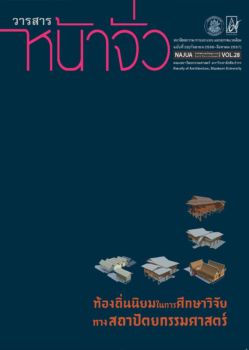การตัดถนนในพระนครกับผลประโยชน์ทางเศรษฐกิจของชนชั้นนำสยาม
Keywords:
ถนน, กรุงเทพมหานคร, สาธารณประโยชน์, ชนชั้นนำ, การพัฒนาที่ดิน, ธุรกิจอสังหาริมทรัพย์, ตึกแถว, พระบาทสมเด็จพระจอมเกล้าเจ้าอยู่หัว, พระบาทสมเด็จพระจุลจอมเกล้าเจ้าอยู่หัว, สำเพ็ง, บางรัก, ถนนราชดำเนิน, Street, Bangkok, governing tradition, public benefitAbstract
ถนนมีความสำคัญเป็นอย่างยิ่งต่อความเป็นชุมชนเมือง ถนนไม่เพียงแต่เป็นเส้นทางสัญจรตาม คำนิยามพื้นฐานเท่านั้น แต่ยังเป็นพื้นที่ประกอบกิจกรรมทางสังคมอันหลากหลาย ไม่ว่าจะเป็นการค้าขาย การพบปะ การสันทนาการ หรือการเคลื่อนไหวทางการเมือง เป็นทางเชื่อมโยงสถานที่ต่างๆ ภายในเมือง และทำหน้าที่เป็นสื่อในการเคลื่อนย้ายถ่ายเทผู้คนและทรัพยากรจากจุดหนึ่งไปอีกจุดหนึ่ง เป็นตัวนำใน การพัฒนาพื้นที่ที่ยังไม่ได้ใช้ประโยชน์แบบเมืองและขยายเขตเนื้อเมืองออกไป และเป็นภาพลักษณ์ส่วน ใหญ่ให้กับเมืองที่สำคัญ ถนนคือโครงสร้างทางกายภาพที่จำเป็นอย่างยิ่งยวดต่อการดำรงอยู่ของเมือง บทความนี้นำเสนอเนื้อหาเกี่ยวกับถนนในกรุงเทพมหานคร ระหว่างปี ค.ศ. 1782-1910 อันเป็น ช่วงตั้งแต่ปีสถาปนากรุงรัตนโกสินทร์ ไปจนสิ้นสุดรัชกาลที่ 5 โดยมุ่งอภิปรายในประเด็นว่าด้วย เหตุจูงใจของการตัดถนน อันเกี่ยวเนื่องกับประโยชน์สาธารณะ และประโยชน์เฉพาะกลุ่มของ ชนชั้นนำในสังคมสยาม การอภิปรายให้ข้อสรุปว่า แม้รัฐบาลในสมัยรัชกาลที่ 4 และรัชกาลที่ 5 จะชูนโยบายการตัดถนนเพื่อสาธารณประโยชน์ แต่ในเบื้องลึกแล้ว การตัดถนนเป็นจำนวนมาก เกี่ยวโยงกับผลประโยชน์ของชนชั้นสูงในสังคมสยาม อันได้แก่ พระมหากษัตริย์ เจ้านาย ขุนนาง และคหบดี เมื่อเป็นเช่นนี้ การแสวงหาผลประโยชน์ทางเศรษฐกิจของชนชั้นสูง มีส่วนอย่างมาก ในการกระตุ้นให้เกิดการตัดถนน และยังส่งผลกระทบต่อแบบแผนโครงข่ายถนนในพระนคร
The Building of Streets in Bangkok and the Economic Advantages of the Siamese Leading Class
Nattawut Preyawanit, Ph.D., Assistant Professor
Department of Urban Design
Faculty of Architecture, Silpakorn University
Streets are vital elements of a city. They are not only traffic routes as commonly defined, but also places in which diverse social activities are carried out, e.g. trading, socializing, political campaigning, relaxing, connecting and transporting. Due to their association with accessibility, streets are essentially a leading device for urban development and expansion.
The paper is concerned the development of streets in Bangkok during 1782- 1910 which is the period from the year of the Bangkok establishment until the end of the Rama V’s Reign. It focuses on two main questions: why the streets were built? and who are the prime beneficiary of their development? The paper shows that although the government under the Reign of Rama IV and Rama V claimed that the street development projects in Bangkok was initiated for the public sage, it is clear that the street availability not only benefited the public at large, but also open up the opportunity for the leading class in the Siamese society, including the royalty, the aristocrats and the wealthy merchants, who commanded all street projects, to acquire significant economic profits. With this, the paper concludes that the profitmaking motivation of the leading class was one of the key factors that influenced the street development decision-making.





